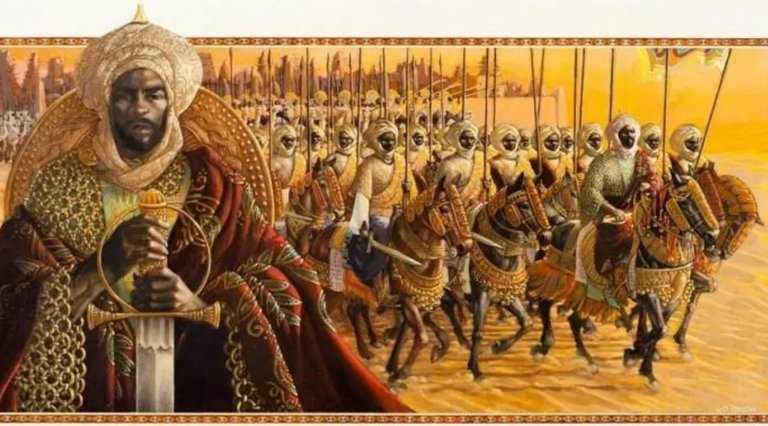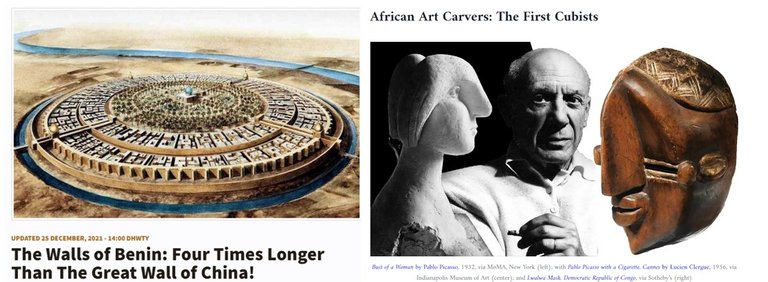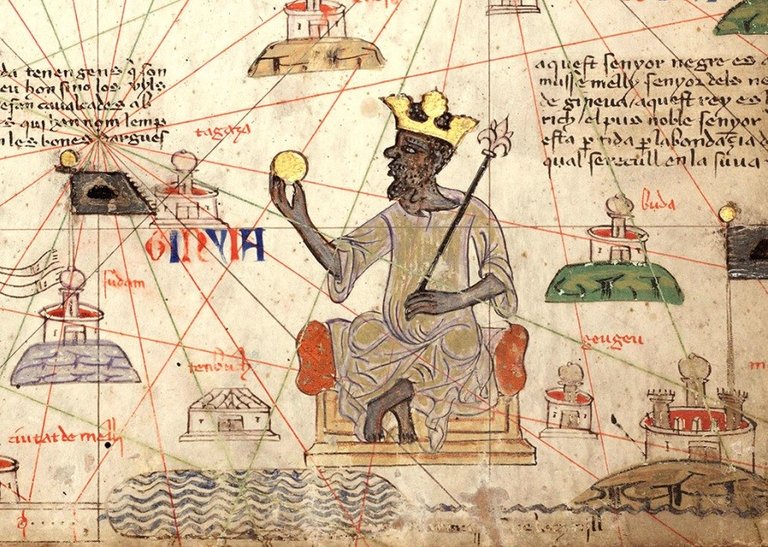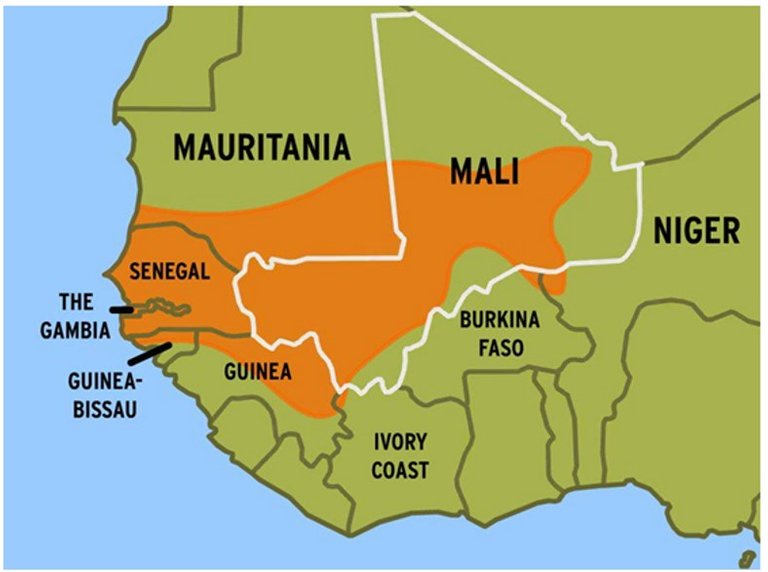By Neenah Payne
Most of the world is taught to think of Africa as backwards, poor, with no history other than that of slavery and ancient Egypt. However, King Leopold II’s Genocide Of The Belgian Congo explains that the Kingdom of Kongo (1375-1884) sent an ambassador to the Vatican in the 1600s (1604-1608). Demands Grow To Return Africa’s Stolen Art shows that the Empire of Benin was one of the longest-lasting empires -- from 1180-1897 AD (over 700 years) in what is now southern Nigeria. The Benin Empire ended only when it was invaded by Britain in the Scramble For Africa fueled by the Berlin Conference of 1884-1885. Otherwise, the Benin Empire might still be in existence today -- almost a thousand years. The Roman Empire lasted just about 500 years from 27 BCE-476 AD.
The walls of Benin (9,900 miles) were the largest earth works in the world -- four times longer than the Great Wall of China -- and they consumed more material than the Great Pyramids of Egypt. Travelers called it “The Great Benin”. Benin’s beautiful art influenced everyone who saw it -- including European cubists like Picasso. Nigeria has been fighting to retrieve its stolen art from Britain, Germany, France, and the US. Beginning in 2021, some of the art began to be returned and Nigeria is building a museum to display its historic treasures.
Mansa Musa: Wealthier Than Today’s Tech Billionaires
When we think of the richest people in history, we might think of today’s multi-billionaires like Jeff Bezos, Elon Musk, Mark Zuckerberg, and Bill Gates. However, as the video below shows, Jeff Bezos would look like a pauper compared to Mansa Musa who ruled the Mali Empire in the 14th century AD. Musa established the University of Timbuktu, the center of learning which had more books than the legendary Library of Alexandria in ancient Egypt.
Mansa Musa was the ruler of the Empire of Mali in West Africa from 1312-1337 AD. He personally owned about half of the world’s known gold reserves. Some reports say that this 14th-century African emperor was the richest person in history and that the wealth of Mansa Musa of Mali was too vast to be imagined—or equaled. At its height, Mali was 478 sq miles. Texas is 269 sq. miles.
When Moors Rescued Europe From The Dark Ages shows that Catholic Europe descended into the Dark Ages after the fall of the Roman Empire in 500 AD. When the Moors ruled Spain from 711-1492, they brought Western Europe out of the Dark Ages.
When Mansa Musa came to power in Mali in the 14th century, European nations were struggling with raging civil wars and a lack of resources. Europe was one of the worst places to live because of rampant famine and various plagues like The Black Death which decimated the entire continent. During that period, the Mali Empire flourished thanks to ample resources like gold and salt.
Meet the Richest Man Who Ever Lived
Mali Empire in 1300s
The video below explains that the Mali Empire was built by Mansa Musa’s great uncle Sundiata Keita in 1230 AD. By 1255, the Mali Empire was the largest Africa had ever seen. At a time when Europe was a land of peasants and warfare, Mansa Musa (Emperor Musa I) was born in 1280. Mansa Musa owned half of the world’s known gold reserves and traded with Venice in Italy and Castille in Spain. He built a cultural powerhouse so great that it rivaled any in the world and he was a legendary figure in his time.
Musa I of Mali: The Real Life King Midas
The people in the Mali Empire were well fed and travel was easy. The video contrasts that with what was happening in Europe at the time. The video explains that in the 13th century, Mali was the sole power in West Africa and was the place to be!
Musa I raised an army of 100,000 men and 10,000 horses. Over the next decade, he doubled Mali’s size. Under Musa I, Mali stretched about the distance from New York to New Mexico -- encompassing half the world’s known gold reserves. Only the Mongolian Empire was larger.
When Musa I, a Muslim, made the nearly 4,000-mile pilgrimage to Mecca as part of his “Hadj” in 1324, he made the trip in a style befitting the richest man who has ever lived. He led a caravan of 60,000 men, 12,000 slaves, tens of thousands of sheep for food, and 100 camels. Everyone was wearing gold brocade and luxury Persian silk. The first 500 slaves each carried three kilos of solid gold. Each of the 100 camels was loaded down with 135 kilos of gold. The voyage to Mecca was 2,700, about the distance from New York City to San Francisco which is 2,900 miles!
The extensive trade networks and zest for learning in Africa at this time has led many to consider it a ‘golden age’. This was particularly true of Mali, which had grown to be the largest empire in West Africa since its establishment in the 13th century by Mansa Musa’s great-uncle, Sundiata Keita. Despite this, however, the Malian Empire was little known outside of the continent until Musa’s famous pilgrimage. News of the emperor’s opulence spread far and wide and may have first planted the idea in Europe that Africa was a place full of resources.
On the way to Mecca, Musa conquered the Songhai Kingdom. His conquests finally brought Timbuktu under his control, adding that city to his immense wealth. However, the real fireworks started when Musa I reached Cairo which was considered the richest city. From that point on, Musa I’s name would pass into legend. In 1375, a Swedish geographer heard in Cairo about Musa’s fame that he created the first map of West Africa. That map included an image of Musa.
Musa I recruited a famous architect from Cairo to transform Timbuktu to rival Mecca in its grandeur. He built the Djinguereber Mosque, the greatest mosque Africa had ever seen and one of the greatest examples of religious architecture in history. Today, it is recognized as architectural masterpiece and still functions as a mosque over 700 years later. Musa I had schools, universities, and libraries built in Timbuktu. In the 14th century, Timbuktu became what Paris was in the 19th century.
Musa’s empire included current-day Senegal, Gambia, Guinea, Niger, Nigeria, Chad, Mauritania, and Mali.
The video says, “This great city in this great empire became the entire focal point of a continent”. Right up to the 18th century, Timbuktu was the El Dorado of Africa -- a place of legend where the streets were said to be paved with gold. This inspired Europeans to explore the Gold Coast of Africa.
Musa built an empire that rivalled any in Europe or Asia. He had patronized a culture of learning in a region Europe had written off as a place of savages. Musa I of Mali remains one of history’s great leaders. When Musa I died in 1337, the Mali Empire declined and finally collapsed in the mid-15th century. By 1464, the Songhai Kingdom had grown so strong that it declared its independence.
Word of Musa’s wealth and influence spread beyond Africa after his 2-year voyage to Mecca. Tales of his enormous convoy and generosity continued to be passed on long after his death. By the late 14th century, Musa had been drawn in the 1375 Catalan Atlas, an important resource for navigators of Medieval Europe. Created by Spanish cartographer Abraham Cresques, the atlas depicted Musa sitting on a throne with a gold scepter and crown, holding a gold nugget.
This 14th-Century African Emperor Remains the Richest Person reports:
“As far as wealth goes, it is nearly impossible to quantify the riches that Musa had during his lifetime. The vastness of Musa’s land and material holdings, University of Michigan associate history professor Rudolph Ware explained in Time, seems downright incomprehensible today: 'Imagine as much gold as you think a human being could possess and double it, that’s what all the accounts are trying to communicate,' he said. 'This is the richest guy anyone has ever seen.'"
The 2018 video below explains that the Mali Empire was the largest African empire and the main influence in West Africa. Mansa Musa conquered over 24 cities in 10 countries. He founded the first university in the region.
His empire was the largest gold producer and one of the biggest trading regions in the world. Mali was selling gold and salt at a time when Europe was poor and starving and was struggling to those commodities. Musa is said by many to have been the richest person to ever live with a net worth of over $400 billion -- four times the worth of Amazon’s Jeff Bezos, one of the richest men today.
Musa’s pilgrimage to Mecca made him famous all over the world. He shaped the view of Mali as a place of wealth, splendor, and sophistication. The video says Mansa Musa’s life may be turned into a movie.
15 Things You Didn't Know About Mansa Musa
MANSA MUSA: A Revolutionary view of Education & Wealth In 14th Century Mali
The Story of Mansa Musa: The Wealthiest Person Who Ever Lived
Timbuktu was the most important trade center in Africa. The video below explains that Musa made the university he built in Timbuktu one of the greatest centers of learning in the Islamic world where law, astronomy, medicine, religion, and other disciplines were taught. The university had 25,000 students with 800,000 manuscripts -- one of the largest libraries in the world. The Mali empire included parts of today’s Nigeria, Burkina Faso, Niger, Mali, Senegal, Gambia, Guinea, Guinea Bissau, Ivory Coast, Mauritania, and Chad.
Was Mansa Musa the Wealthiest Person Who Ever Lived?
The video below says that students from Spain, Egypt, and Morocco studied in the universities of Timbuktu.
The hidden treasures of Timbuktu - Elizabeth Cox
"Dig into the ancient manuscripts, scrolls, and books of Timbuktu— and find out why they’ve been hidden for centuries."
Greatest African Dynasties | Top 10 Countdown
- House of Solomon (1270-1974: 704 years) (Ethiopia)
- Mali Empire (1230-1670: 440 years)
- Benin Empire (1300-1897: 597 years) (Nigeria)
- Bornu Empire (10-85-1846: 761 years) (Chad)
- Morocco (1656-Present: 354+ years)
- Ghana Empire (700-1078: 378 years)
- Rozvi Empire (1684-1889: 205 years) Zimbabwe
- Kingdom of Kongo (1390-1567: 177 years)
- Songhai Empire (1493-1590: 97 years)
- House of Zulu (1816-1897: 81 years) (South Africa)
How Europe Planned To Steal Mansa Musa’s Gold
The video below says that nearly half of all gold sold and bought in Africa, Asia, and Europe in the 14th century came from just three mines in Mali! It was equally rich in salt which was prized everywhere. Our word “salary” comes from the Latin word “sal” because Roman soldiers were reportedly paid in salt. The Mali Empire was recognized around the world as a rich, powerful, and almost magical place.The Bizarre Life Of History's Richest Man: Mansa Musa
The video below explains that Mansa Musa controlled what was likely the wealthiest empire on Earth in the 14th century. It was during Musa’s two-year pilgrimage to Mecca that the world became aware of the astonishing wealth of Mali. When the Catalan Atlas was published in 1375 showing Musa holding a large gold nugget, European leaders started sponsoring “explorers” to Africa to find the source of Mansa Musa’s gold.
How Europe Planned to Steal from African King Mansa Musa Richest Human Ever
Who Really Was The World’s Richest Person?
The video below claims that Mansa Musa was NOT the richest person in history -- only the richest person of his time. It says he was only the sixth richest person in history with the equivalent of $415 billion in today’s money.
The video lists the following people in order of their wealth:
- Genghis Khan (Temujin) -- Ruler of Mongol Empire 1206-1227: $100 trillion
- Shen Song -- Chinese emperor 1067-1085: $30 trillion
- Akbar I -- Ruler of India’s Mughal Empire 1556-1605.: $21 trillion
- Augustus Caesar -- First Roman emperor 63 BC-14 AD: $4.6 trillion
- King Solomon -- King of Israel 970-931 BC: $2.2 trillion
- Mansa Musa I -- Emperor of Mali 1312-1337: $415 billion
- John D. Rockefeller -- Standard Oil tycoon 1839 -1937: $400 billion
- Nicholas Romanov -- Last Russian emperor 1868 -1918: $300 billion
- Osman Ali Khan -- Last ruler of Hyderabad in India 1911-1948: $230 billion
- William The Conqueror -- First king of England 1028 -1087: $228 billion
Top image: History
Neenah Payne writes for Activist Post and Natural Blaze
Subscribe to Activist Post for truth, peace, and freedom news. Follow us on SoMee, Telegram, HIVE, Flote, Minds, MeWe, Twitter, Gab, What Really Happened and GETTR.
Provide, Protect and Profit from what’s coming! Get a free issue of Counter Markets today.




